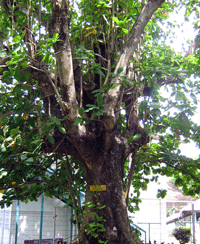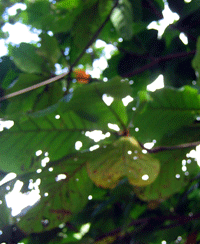
Akasia | Angsana | Asam Jawa | Jambu Laut | Jemerlang | Ketapang | Mambu | Mempari | Pukul Lima | Sentang

INTRODUCTION
Tropical-Almond is a 30 to 55-foot-tall, deciduous
tree which forms a symmetrical, upright silhouette in
youth with horizontal branches reaching 35 feet in
width. The branches are arranged in obvious
tiers, giving the tree a pagoda-like shape. As the tree
grows older, the crown spreads and flattens on the top
to form a wide-spreading vase shape. The large, 12-
inch-long and six-inch-wide, glossy green, leathery
leaves change to beautiful shades of red, yellow, and
purple before dropping in winter. Due to their large
size, these old leaves may be considered a nuisance to
some people. The leaves are quickly replaced by new
growth so the tree is bare for only a short period of
time. The inconspicuous, greenish-white, springtime
blossoms appear in six-inch-long terminal clusters and
are followed by the edible fruits. These drupes are 2.5
inches long and mature from green to yellow or red
during the summer. The outside husk is corky fiber
with an inner thin green flesh. The inside holds the
edible, almond-like kernel. The fruit is high in tannic
acid and this could stain cars, pavement and sidewalks.
It also causes significant litter on the ground.
GENERAL INFORMATION
Scientific name: Terminalia catappa
Pronunciation: ter-mih-NAIL-ee-uh kuh-TAP-uh
Common name(s): Tropical-Almond, India-Almond
Family: Combretaceae
USDA hardiness zones: 10B through 11 (Fig. 2)
Origin: not native to North America
Uses: large parking lot islands (> 200 square feet in
size); medium-sized parking lot islands (100-200
square feet in size); recommended for buffer strips
around parking lots or for median strip plantings in the
highway; shade tree; small parking lot islands (< 100
square feet in size); specimen; residential street tree;
no proven urban tolerance
Availability: grown in small quantities by a small
number of nurseries
Flower
Flower color: green
Flower characteristics: inconspicuous and not
showy; spring flowering
Fruit
Fruit shape: elongated; oval
Fruit length: 1 to 3 inches
Fruit covering: dry or hard
Fruit color: tan
Fruit characteristics: does not attract wildlife;
inconspicuous and not showy; fruit, twigs, or foliage
cause significant litter
USE AND MANAGEMENT
The tree may be best suited for planting along the
coast as a park or shade tree providing dense shade.
People may object to the large leaves and the fruit that
falls from the tree if the tree is used as a street tree,
and the tannic acid may be a problem near parked
cars. Branches droop and require regular maintenance
to keep them pruned to allow for vehicle clearance
beneath the canopy. However, it would make a nice
tree for a median or along a boulevard where this
would cause less of a nuisance.
Tropical-Almond should be grown in full sun on any well-drained soil. Plants are quite tolerant of wind, salt, and drought but do need protection from freezing temperatures. Trees perform best if mulched and regularly fertilized.
Propagation is by seed.
